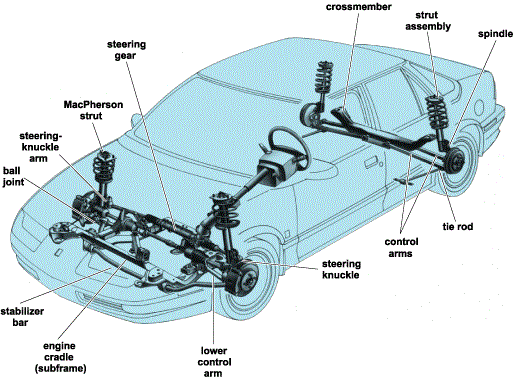
A car’s suspension system is designed to last for years. Indeed, if you drive with care, you can expect it to last up to 75,000 miles or about 4 to 5 years. And if you buy high-quality replacement suspension components from trustworthy suppliers like https://www.carparts.com/, then you can expect an even longer lifespan. In fact, if you drive mostly on smooth roads, you can count on your car’s suspension to last up to 8 to 10 years.
Still, no matter how tough your car’s suspension may be, it will not last forever. Regular wear and tear can weaken and break down parts, which can compromise your driving comfort and safety. Thus, you need to know when to replace your car’s suspension to avoid bumpy rides and nasty accidents. Thankfully, there are a lot of warning signs that can clue you in on the condition of your vehicle’s suspension system. Here are some key symptoms you should watch out for:
A Rough Ride
One of the clearest indications of a worn-down suspension system is a rough ride. When even the smallest bump makes your car bounce and jump, it’s about time to have shocks inspected and replaced. If you don’t want to drive over potholes to check ride quality, you can do a simple bounce test when your car is parked. Simply push your entire weight down on the front of your car and then release. You should notice very little bouncing if your suspension is in good shape. If it visibly bounces more than three times and takes a little while to stop, have the shocks and/or struts replaced immediately. Air suspension is a great way to smooth out your ride also. Check out the Air Suspension on this 2015 Dodge Charger.
Your Car Pulls or Drifts While Turning
There are plenty of reasons why your car pulls to one side while driving, especially when taking turns. Poor alignment is usually the main culprit, although this can also be caused by damaged tie rods or a sticking brake caliper. A bad suspension system can also cause your car to feel unstable. This is because the shocks are no longer able to “hold” the chassis steady, causing it to drift. You might even feel like your car is about to roll over.
Have your car’s alignment checked first and make sure the tires are properly inflated. If these aren’t the reasons behind the pulling or drifting, have your suspension system checked next. You might need to replace a few key components.
The Car Nose-Dives When You Brake
Another clear sign of a failing suspension is when you feel your car’s nose leaning forward and down when you press a little too hard on the brakes. This is not just uncomfortable, it’s also dangerous. That’s because poor suspension can result in up to a 20 percent increase in the time your car needs to stop completely. You should also take note if your car leans back or “squats” when you accelerate. If you experience these, then your car’s shocks or struts are due for a replacement.
Do note that your car can also nose-dive or squat in extreme conditions, even with new shocks or struts. However, it’s another story if your car leans forward or tilts backward during your daily drives.
The Shocks Are Oily
There are a lot of visual and physical inspections that you can do to diagnose your car’s suspension kits system. One of these is the aforementioned bounce test while parked. Another one you can easily do in your own garage is to look under your car and see if the shocks or struts are oily or greasy. If they are, this means that they’re leaking fluid and thus have a lower capacity of absorbing shocks and bumps. Have them checked and replaced as soon as possible.
Your Car Is Difficult to Steer
Is your car proving a little difficult to steer, even at slow speeds? Do you feel a slipping sensation when you hold the steering wheel turned left or right? Something might be wrong with your power steering and suspension systems, which are designed to work together to ensure a smooth driving experience. Some of the components that you should have inspected are the power steering belt, power steering fluid, and the control arm bushings. When this is complete you will need a full suspension alignment to make it ride down the road startight.
Your Car Looks Lopsided
Here’s another visual inspection you can do to check your car’s suspension: look at it and take note of any sagging. If one side or corner sits lower than the others, you might have a damaged spring. You can also do another bounce test, this time on your car’s trunk or rear. Push down on it and release, paying extra attention to any squeaking, creaking, or clunking sounds. If you notice any, your car’s bushings, shocks, or springs may have problems.
Again, your vehicle’s suspension system is important in keeping you comfortable and safe while out on the road. Keep these warning signs in mind so you can quickly figure out any problems. This way, you can have things checked and replaced before things get any worse.










